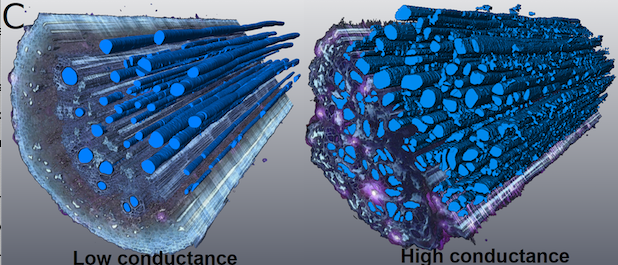
Cross-sections of bean roots showing low and high conductance
Authors
Christopher F. Strock, James D. Burridge, Miranda D. Niemiec, Kathleen M. Brown, Jonathan P. Lynch
Source
Plant, Cell and Environment 44: 49-67
Download options
Abstract
At the genus and species level, variation in root anatomy and architecture may interact to affect strategies of drought avoidance. To investigate this idea, root anatomy and architecture of the drought-sensitive common bean (Phaseolus vulgaris) and drought-adapted tepary bean (Phaseolus acutifolius) were analyzed in relation to water use under terminal drought. Intraspecific variation for metaxylem anatomy and axial conductance was found in the roots of both species. Genotypes with high-conductance root metaxylem phenotypes acquired and transpired more water per unit leaf area, shoot mass, and root mass than genotypes with low-conductance metaxylem phenotypes. Interspecific variation in root architecture and root depth was observed where P. acutifolius has a deeper distribution of root length than P. vulgaris. In the deeper-rooted P. acutifolius, genotypes with high root conductance were better able to exploit deep soil water than genotypes with low root axial conductance. Contrastingly, in the shallower-rooted P. vulgaris, genotypes with low root axial conductance had improved water status through conservation of soil moisture for sustained water capture later in the season. These results indicate that metaxylem morphology interacts with root system depth to determine a strategy of drought avoidance and illustrate synergism among architectural and anatomical phenotypes for root function.

